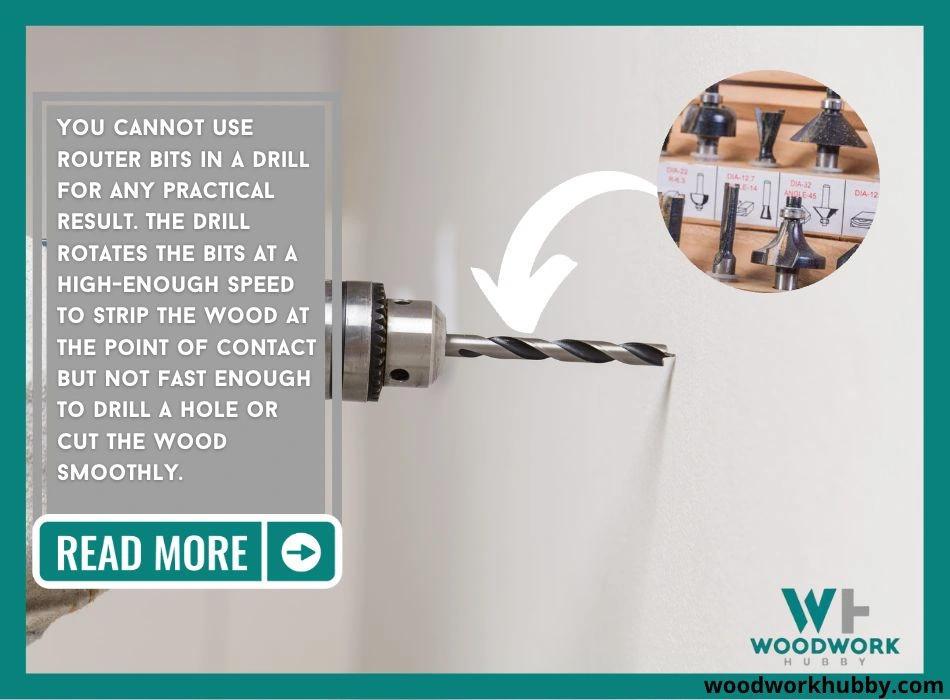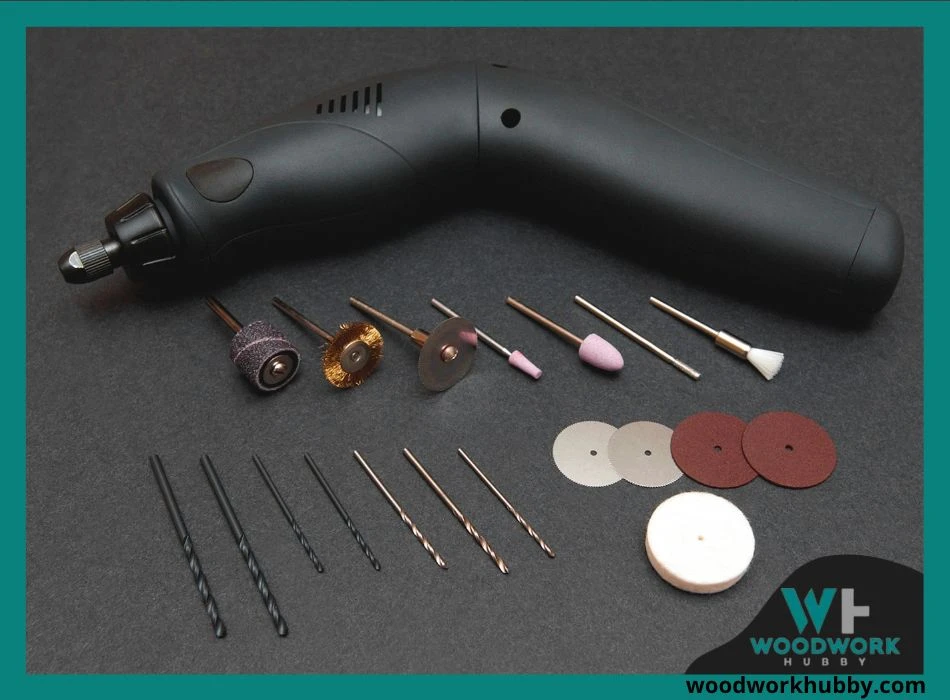Any time one tool in my workshop stops working, I figure out a use for another tool that I previously didn’t know. And the secret behind that is experimentation. My latest experiment came after my router stopped working randomly. I decided to use a router bit in a drill.
You cannot use router bits in a drill for any practical result. The drill rotates the bits at a high-enough speed to strip the wood at the point of contact but not fast enough to drill a hole or cut the wood smoothly.
In this article, you will learn what I found from using router bits in a drill, Dremel, and drill press, alongside the best practices of cutting wood with a drill. By the end of this post, you’ll know what to use for routing if your router stops working and how to use your handheld drill to cut wood. Let’s get started with the fundamental difference between wood and a drill bit.
Drill Vs. Router: A Brief Overview

Before you latch a router bit onto a drill, you must understand a few fundamental differences that are relevant to the cross-usage of router bits on a drill and vice-versa.
Drills Rotate Router Bits At A Slower Pace
Drills can be 20 times slower rotating than routers because they are meant to be plunged into materials, which is an action that requires less force than sideways cutting. And sideways cutting is what routers do best.
Smaller Router Bits Are Effective At Low Speeds
While router bits are meant to perform at high Rotations Per Minute (RPM), their size affects how well they cut at different speeds.
Using router bits in a drill will most likely end in broken router bits.
To see how scale affects cutting potential, think of using a ceiling fan and a windmill. A ceiling fan’s motor cannot rotate a windmill fan at a high enough speed to chop anything. A ceiling fan, on the other hand, moves at a high enough pace to be a direct amputation risk.
In other words, slower motors can make smaller tools move fast enough for cutting. The same motos aren’t equipped to move larger tools fast enough. This principle also applies to drills, which is why you cannot use all router bits in a drill press or a handheld drill.
Here are the results of using router bits in a handheld drill
A video demonstration to check if you can use a router bit in a drill.
There’s a lot more hope for router bits to be useful in a drill press instead.
Can You Use Router Bits In A Drill Press?
You can use router bits in a drill press as long as they are small. Most router bits give an average cutting performance in a drill press and make a huge mess of sawdust and wood chips in the process. Router bits are not as good as drill bits in this context.
You cannot use large router bits in a drill press because the larger bits are slower and don’t build enough momentum to efficiently cut through wood. To understand this, you need to know how router bit and drill press movements align.
A drill bit is meant to cut through forward penetration, while a router bit is meant to cut with sideways contact. In other words, the drill stabs a surface to cut it while a router slices through it. This means the drill bits rely on tips to cut through the wood.
A router bit has durable and sometimes sharpened sides that cut through a material being pushed through it. Both the drill bit and router bit require rotation to function.
A drill bit can get further will less rotation as it has a small-surface tip to lean on. In contrast, the router bit has to move much faster as its sides aren’t as sharp as a drill bit’s tip.
Your drill press, even at its highest speed settings, is probably not fast enough to make clean cuts and effortless mortises with a router bit. But since small router bits can do a decent job with a low spin velocity, they can make a passable cut when used in a drill press.
The following video shows a round-over bit being used in a drill press.
A video demonstration to check if you can use router bits in a drill press.
As you will notice, the router bit, despite being installed in a drill press, is not being used as a drill bit. Instead, the press is being used as a router. And that’s probably the closest you can get to using a round-over router bit effectively in a drill.
If you plan on using a router bit for actual drilling, then you must brush up on specific ones compatible with drills. Not all router bits can be used to drill.
Can Router Bits Be Used In A Drill?
You cannot use router bits in a drill and get good results. Most router bits make poor drill bits because of their design being specialized for sideways cutting. Straight router bits are the only router bits that can be used to drill holes with downward pressure.
In other words, you can use a straight router bit to drill holes, but the bit needs to have enough speed to produce aesthetic results. Given that drills rotate their bits at 9 to 15 times lower speeds than routers, it is safe to say that router bits would be inefficient at best and ineffective at words if used in a drill.
The operating principle isn’t the problem, but the RPM of the drill is what limits router bits from being of any use when mounted on it. This brings us to the question of higher RPM machines like Dremel.
Can You Use Router Bits In A Dremel?

You can use some router bits in a Dremel if you choose to use a Dremel for routing. The Dremel can also be used for plunge-drilling if a straight router bit is used on it. The RPM of a Dremel is high enough to make efficient use of the router bits, but the specific application of the Dremel needs to match the tool.
There are two Dremel attachments that accommodate router bits. The first is the Dremel 231 Shaper, which is meant to be used for shaping via sideways cutting. And the second one is the 335 Plunge router accessory, which allows you to drive the router into a stationary surface safely.
Dremel itself is a powerful rotary tool which an RPM of 5 to 9 times higher than that of an average drill. That’s why it can rotate router bits fast enough to get them to work. With that said, Dremel is handheld and can prove unstable for using the router bits for shaping, cutting, or drilling.
The uses of router bits in Dremel include:
- Drilling – 335 Dremel Plunge Router accessory holds the Dremel tool over the material you want to cut and then lets you drive the Dremel into the stationary material. It can help you drill, provided that you use a straight router bit of sufficient length.
- Shaping – Dremel 231 shaper/router table is a good accessory that holds the Dremel still while providing a platform across which you can move the wood that you want to cut with the router bit. Most router bits should work in this setting, provided they fit the Dremel.
- Sanding – Dremel 231 router table can be used for sanding, as the surface can be moved against the router bit. It is a focus-intensive task but can definitely be executed.
- Cutting – 335 Dremel plunge router accessory is better at cutting with a Dremel than a router table attachment. Both machines work, though, as long as the router bit fits properly in the Dremel.
As you can see, the issue isn’t that the Dremel’s RPM or functionality is incompatible with a router bit. It is that router bits don’t always fit a Dremel. Knowing the type of router bits that fit a Dremel beforehand will help you avoid disappointment.
Which Size Router Bits Work In A Dremel?
Most router bits with ⅛ Shank work in a Dremel. But if you want to be sure that the router bits you purchase work in a Dremel, get the bits sold by Dremel. The Dremel 692 6-Piece Router Bit Set features six different router bits that work with a Dremel for up to 30,000 RPM speed.
Dremel 692 6-Piece Router Bit Set
This set has over a thousand reviews and ratings that collectively add up to 4.6 stars out of 5 stars. That’s among the top 1% review averages for power tool accessories on Amazon. Its highest specific rating is for its ease of use, which stands at 4.1 stars on a 5-star scale.
How To Use A Drill To Cut Wood?
A drill cannot cut wood the same way a router can, but you can still use it to cut the wood into two pieces, provided that the wood is not too thick for the drill bit to drive through.
If a drill bit can go from the face of the wood and come out from the back, then you can cut that piece of wood using a drill bit. Here are to steps you need to take.
- Step 1 – Add your longest and slimmest drill bit to the drill – This ensures that the drill drives through the wood surface instead of making a hole that goes halfway.
- Step 2 – Lay the wood on a flat surface – This can be the floor or your workbench. As long as the wood is stable, you can proceed to the next step.
- Step 3 – Draw a straight line with chalk to indicate where the wood will be cut – This will help avoid inaccuracies at the drilling stage.
- Step 4 – Move the wood, so the marked surface is suspended in the air – The drill will go through the wood, and you don’t want it driving into your workbench. Suspending the wood between workhorses or setting it on the table while it is suspended one side off of it can ensure that the drill does no damage to the area underneath.
- Step 5 – Drill holes in succession across the line – Make sure the holes are close enough to each other. If they are not, you can get them to be by going over the surface another time and adding more holes. This is essentially a dotted line.
- Step 6 – Break the wood into two pieces by applying pressure – If you have executed the previous step properly, the wood will break into two pieces when you apply pressure by hand. If it does not, you can add more holes to the line until it eventually breaks.
In my experience, it takes ten to twenty times as long to cut wood with a drill. I did it as an experiment and wouldn’t recommend it as a practical alternative to a saw or a router.
Final Thoughts – Can You Use Router Bits In A Drill?
There is a reason why router bits are used in routers instead of drills. Routers rotate at a 9 to 20 times higher speed than handheld drills and drill presses, making their tools spin at a high enough velocity to cut sideways in a smooth fashion.
Dremel tools are the best mid-way tools that can be used for routing and drilling, but they need separate accessories to perform these functions.





